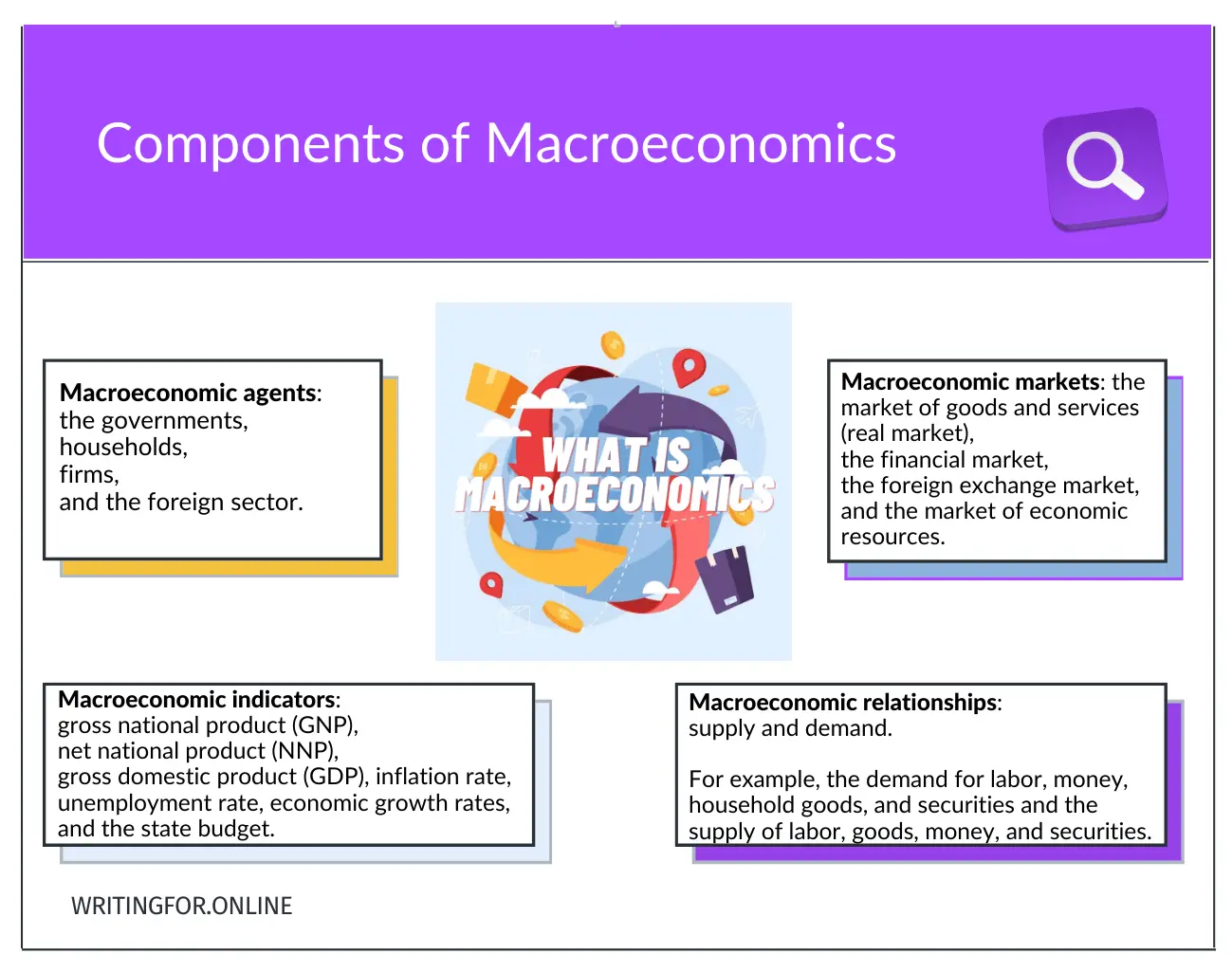Exchange rates, unemployment rates, and stock returns are only a small part of the macroeconomic processes that shape the economic environment in which we live. It turns out that macroeconomics affects the daily life of each of us, and knowing its basics is not of value exclusively for entrepreneurs.
Understanding the general principles and fundamentals of macroeconomics is necessary for everyone: a consumer, an investor, a worker, and, of course, an entrepreneur.
The purpose of this article is to give you a general understanding of what macroeconomics is. You will also learn:
- What is macroeconomics?
- What does macroeconomics study?
- Its main goals.
- Macroeconomic agents: households, governments, firms, and the foreign sector.
What Is Macroeconomics: Definition
Macroeconomics is a branch of economic theory that deals with the study of the economy as a whole or the study of its major components (aggregates).

Macroeconomists study such questions as:
What makes the business cycle fluctuate; what makes economic growth go up and down; how are prices determined; what is the rate of inflation, and what determines it; what is productivity growth; and what are the determinants of productivity?
Importantly, macroeconomists also study the role the government has in determining the pace of growth, the long-run rate of potential output in an economy, and the inflation rate.
Components of Macroeconomics

Thus, the subject of macroeconomics is the study of certain economic units. In this case, the units or components are:
- macroeconomic agents: the governments, households, firms, and the foreign sector;
- macroeconomic markets: the market of goods and services (real market), the financial market, the foreign exchange market, and the market of economic resources;
- macroeconomic indicators: gross national product (GNP), net national product (NNP), gross domestic product (GDP), inflation rate, unemployment rate, economic growth rates, and the state budget;
- macroeconomic relationships: supply and demand. For example, the demand for labor, money, household goods, and securities and the supply of labor, goods, money, and securities. Read also post “What Is the Labor Market: Definition, Analysis, and Characteristics.”
What Is the Main Goal of Macroeconomics
The main goal of macroeconomics is the study of common problems for the entire economy, in contrast to microeconomics, which is aimed at studying the economic behavior of individual economic entities.
What Does Macroeconomics Study?
Macroeconomics aims to study the following problems:
- economic cycle and its causes;
- economic growth and its rates;
- employment rate;
- unemployment;
- general price level;
- inflation;
- money circulation;
- interest rate;
- state budget and deficit financing;
- exchange rate;
- payment balance.
All these issues cannot be considered from the position of microeconomics, that is, from the level of an individual consumer or company. In this case, an integrated approach is needed, which is exactly what macroeconomic analysis provides.
What are the 5 Macroeconomics Goals?
Macroeconomics not only describes economic processes, but its main five goals are also:
- Identification of patterns and dependencies between macroeconomic phenomena and processes.
- The study of cause-and-effect relationships in the economy.
- Assessing the economic situation and identifying ways to improve it.
- Development of the principles of the state economic policy.
- Making forecasts that allow foreseeing the further development of economic processes, as well as the emergence of future economic problems.
Macroeconomic Agents or Subjects
There are four macroeconomic agents:
- Households.
- Firms.
- Governments.
- Foreign sector.
Let’s consider these concepts in more detail.
Macroeconomic Agent: Households
Households are independent macroeconomic agents whose goal is to maximize utility or satisfy their own needs.
Households are the owners of such economic resources as labor, land, entrepreneurial ability, and capital.
By selling economic resources, the household receives income, which it distributes for consumption (buys goods and services) and savings (forms its assets).
Macroeconomic Agent: Firms
Firms are independent macroeconomic agents whose goal is to maximize profits.
Firms are the main goods and services producers and buyers of economic resources (labor, land, capital).
Macroeconomic Agent: Governments
The government is a set of state organizations and institutions that have the right to regulate the economy and influence various economic processes.
The government’s main task is to improve the welfare of society by producing public goods (social protection, security, health care, etc.).
How Does the Government Influence the Macroeconomy?
In addition to being a producer of public goods, the government is also a buyer of goods and services, a lender or borrower of funds, and a redistributor of national income (for example, through the tax system).
The government regulates the economy in such a way as to achieve stable economic growth, full employment of resources, and stable prices. Stabilization or macroeconomic policy of the government includes:
- fiscal policy;
- monetary and credit policy;
- foreign trade policy.
Macroeconomic Agent: The Foreign Sector
The foreign sector is a macroeconomic agent that includes all economic entities outside the country.
This macroeconomic entity interacts with the country through international trade (export and import of goods and services) and the movement of capital (capital export and import).
P. S.: Did you like this post? Please, share it with your friends, thank you! Have a nice day!
Images: freepik.com